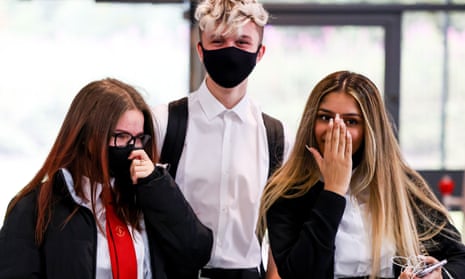Hours after the Scottish government gave secondary schools “obligatory” guidance that pupils should wear face coverings in corridors, communal areas and school buses, Boris Johnson appeared to at least partially give into calls from teachers and parents on face masks, mandating their use in secondary schools situated in areas of England subject to tighter coronavirus restrictions.
He also gave other parts of England the discretion to make their own rules, dropping guidance against using face coverings. But what are the arguments for and against making them compulsory across all English secondary schools?
The case for masks in secondary schools
Expert advice: This weekend the World Health Organization and Unicef endorsed the use of masks in children aged 12 and over for the first time, in particular when 1 metre distance cannot be guaranteed and there is widespread transmission in the area.
Scientific evidence: Recent research suggests teenagers transmit the virus more than young children – but less than adults. “We now have evidence that teenagers and secondary school students transmit viruses slightly less than adults, but significantly more than primary school children. So there is an argument for them to be wearing them,” said Susan Michie, a professor of health psychology at University College London.
Behavioural impact: Wearing a mask is something you have to do actively, and it reminds you a crisis is happening, said Daniel Read, a professor of behavioural science at Warwick business school. “It gives a sense, I think, of responsibility, not just to students but to everybody that they’re a member of society and they’re doing something for the greater good.” Over-11s in England are already expected to wear masks in shops, on public transport and in other enclosed spaces.
The case against masks in secondary schools
Expert advice: Prof Russell Viner, a member of the government’s Scientific Advisory Group for Emergencies (Sage), said there was concern about younger children wearing face coverings. “There are lots of concerns about mask-wearing for children, particularly younger children. Because they touch their face, they are constantly worried about the mask, it actually could spread the virus more,” he said.
Michie said: “What is very important is that the secondary school children are taught about how to put masks on and off, and not to fiddle with them, not to share them with each other.” She added that schools must provide easy access to hot water and sanitiser, and teach pupils why regular hand hygiene is crucial.Scientific evidence: Alok Sharma, the business secretary, on Tuesday highlighted statistics from Public Health England showing that in June there were on average around a million children in preschool and primary settings and just 70 incidents of infection. “The chances of being infected in school are incredibly low,” he told Sky News. “In fact, the chance of being infected are higher outside of a school setting.”
Behavioural impact: Before changing course on Tuesday, No 10 had said it was not changing its guidance on masks in schools in England, partly because “face coverings could obstruct communication between teachers and pupils”.
